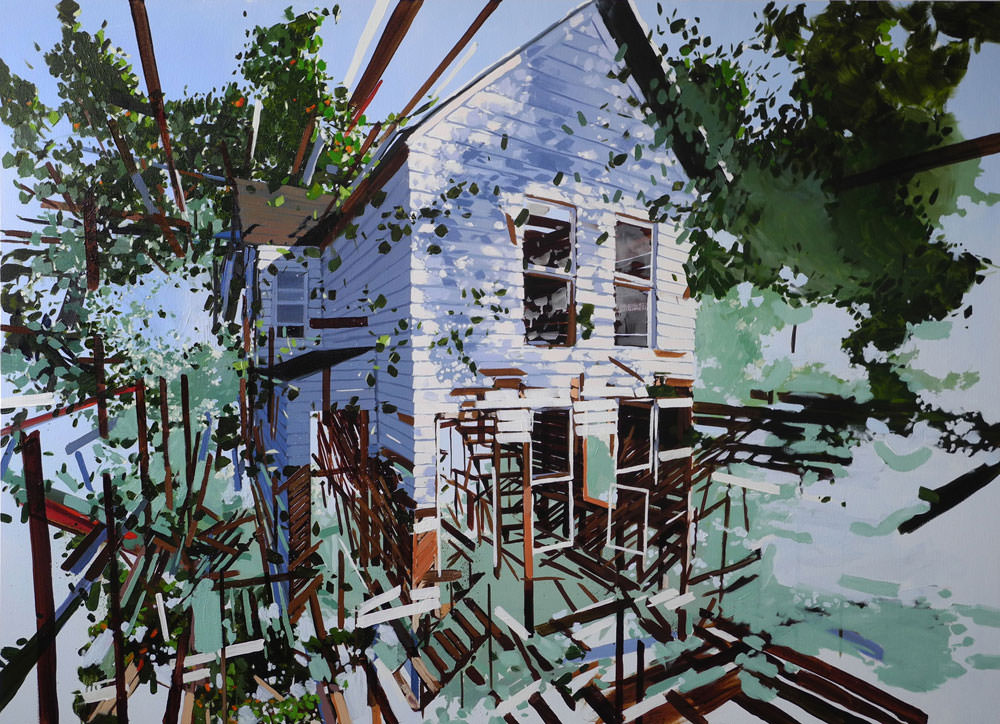Deconstructing Ben Grasso, Dirty Laundry tried to pin down his source of inspiration for disassembling structures. Ben’s paintings pull apart construction, offering a 3-D insight on a two-dimensional canvas, all the while tugging at the feeling of suspension. In his Q&A, the unexpected ice sculptor talked about his artistic process, and his back-burner dreams to one day go Bauhaus on a budget.
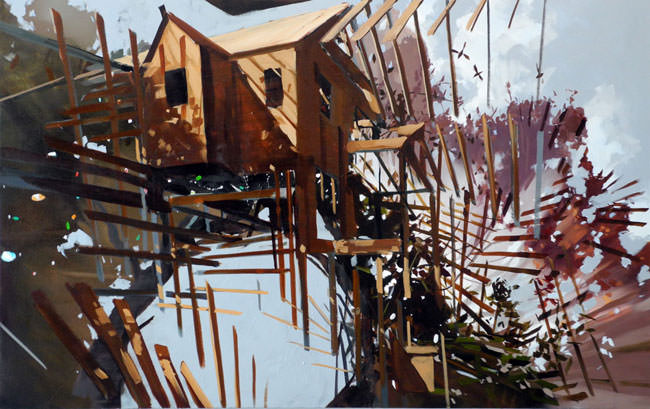

Fall Together
How did your path to becoming an artist develop? Do you remember a specific moment that made you want to be an artist?
I grew up in an environment that was encouraging. My parents were supportive and my dad was an illustrator for years. I was lucky in that way. When my dad was freelancing on weekends my brother and I were hanging out making clay sculptures and drawing. I was the kid in school drawing on everything. To this day I solve most practical problems through drawing.
It takes me a while to get back into a place where I can ignore my phone, my email, etc. So my studio practice is like a series of rituals to pull my mind out of the mediated environment and back into my work.
Is your studio filled with drawings and doodles? What is your studio practice like?
I have a small mountain of sketchbooks and a box filled with retired ones. I always have one with me. I spend a lot of time thinking and planning new projects or things not officially related to my work. Painting is a relatively slow process for me compared to how fast everything seems to fall in and out of fashion. It takes me a while to get back into a place where I can ignore my phone, my email, etc. So my studio practice is like a series of rituals to pull my mind out of the mediated environment and back into my work. I generally have many paintings I’m working on at once and I find that this helps build a dialogue between pieces. I try not to rush into a project or a painting and instead work with an idea that has some staying power, or an image that resonates with me. I think the sketchbooks are a way to test out ideas to see if it’s a direction I want to go with my work.
I became interested in the relationship between a mark and a thing, where a mark can feel like an object.
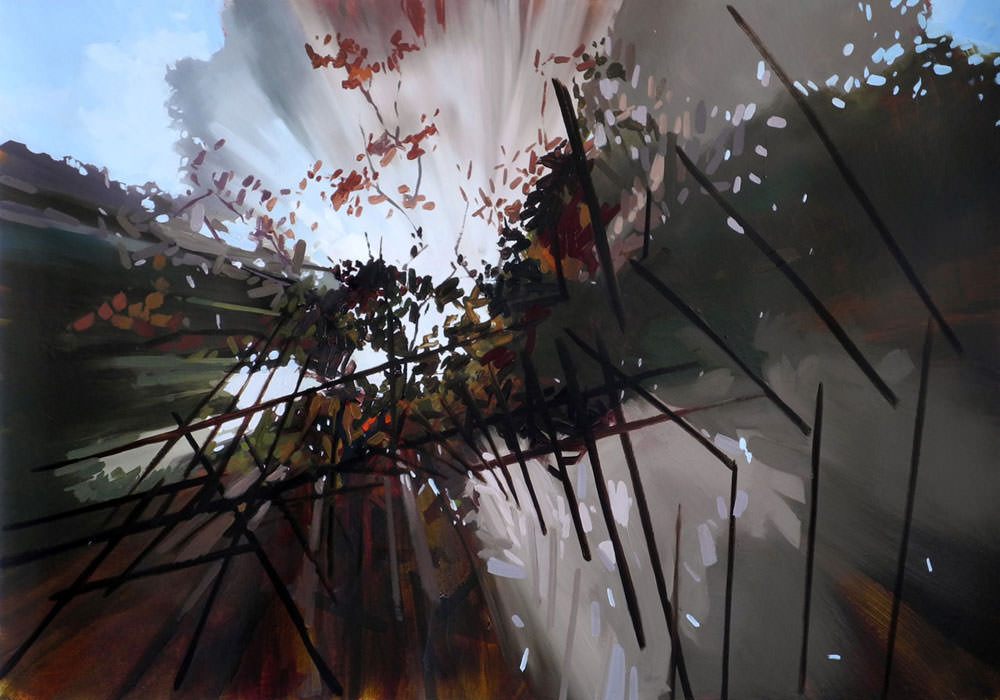

Canopy #5
Do you have anything on in the background while you work? Music, movies, etc.? If so, what?
I listen to music, talk radio, and now podcasts. It’s so funny that I now just take for granted things like iPods; I bought one in 2006 and now can’t imagine not having all that music with me all the time. I sometimes get obsessed with an artist then get obsessed with politics. Politics can be entertaining: social sculpture on one hand and parody on the other. But when it’s an election year, it’s fascinating listening to all the crazy shit people feel like they need to say. I guess it depends on my mood that day or if something really important is happening in the news, but I prefer music because it’s a little less distracting.
Do you have a job outside being an artist? Or are you a full-time painter?
I’m getting closer to being a full-time painter, but I still work for a friend’s ice sculpture studio during the busy months.


Ungrounded
Alongside ice sculptures, I know you build bikes in your spare time. It seems like you have a great passion for building things with your hands. Your paintings touch on a construction theme, but they remain two-dimensional. Are there other forms or mediums you have used or considered using in your work besides painting?
I’ve made a few anemic attempts at sculpture and installation. I suppose I haven’t found the right outlet just yet, but I really enjoy making ice sculptures. I never imagined it’d be something I’d do or be good at and especially not here in New York with the clients we have. Our sculptures have been in Films, TV, magazines, it’s really funny. I love making functional things, and I love making bicycles for that same reason. The “safety bike” is something that never needed any more or fewer things to work, just minor adjustments to make it more suitable to different riders and environments. I imagine myself maybe one day trying my hand at architecture- Bauhaus-minded and on a budget.


Construction Proposal #1, Colored Lights
Your work deals a lot with suspension. The viewer isn’t sure if everything is about to fall apart or come together, so they are stuck in this one single moment of tension. Do you see these images as explosions of something that was once whole, or as pieces coming together to create something new? And what does that mean to you?
I like the idea of suspension. I became interested in the relationship between a mark and a thing, where a mark can feel like an object. I made some early works that used mark-making to describe actions or movement. In those, paint was like a character and images were like a backdrop. Those felt a little heavy-handed. When I made the work for my first show in New York I decided to focus more on making images that were being pulled apart. I felt like in those paintings I could move away from the descriptive quality of some of my earlier work and maybe talk more about this theme of suspension that’s been in a lot of my recent work. Really, I wanted to be able to describe my way around and through a space but have it all in one experience.
I like the idea of understanding the present and working our way backward to the past.
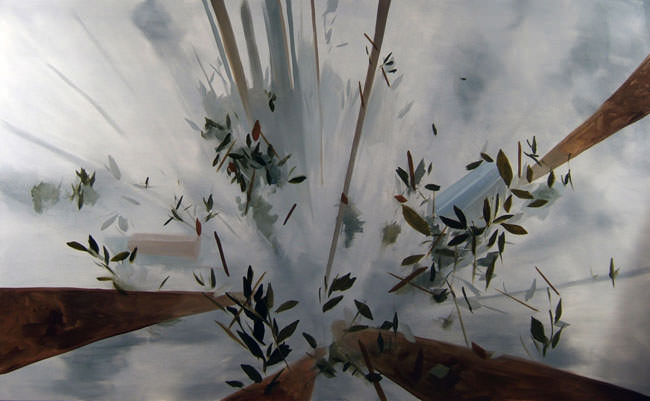

Red and Blue House
How much do your surroundings and location influence you? Talk a bit about the difference between growing up in Cleveland, and then moving to New York, and if/how each city has affected your work.
I first started mining my way through Cleveland’s history, namely because there is this looming sense of failure surrounding it. It’s a perfectly fine place, but due to traces of some former identity, there is this feeling of loss. I like the idea of understanding the present and working our way backward to the past. There are multiple histories in every city; every moment is a living intersection of geography, economics, politics, etc. In New York it’s evident every time a street or a streetcar track is excavated or and stones reemerge from under the asphalt. There is a tradition in the United States of covering our tracks, of paving over history to fit a clean narrative. I like to research these things and find out how things might have worked generations ago.
There is a tradition in the United States of covering our tracks, of paving over history to fit a clean narrative. I like to research these things and find out how things might have worked generations ago.
What are your favorite things to do in New York?
Mostly I love riding a bike and exploring, and getting to the good beaches like Fort Tilden is great. It’s the only time I really feel like I’m getting away while I’m still in the city.
You are very a prolific artist and don’t seem to get too burnt out. What keeps driving you to make new/more work?
Everybody knows that feeling they get when they’ve gotten something to work. It doesn’t happen every time and over the years you’ll take different paths to get to it. For me that’s the hardest part and the most rewarding: when I make the best of the time, resources and the ideas, and something good comes out of it. Also, I can’t think of what I’d be doing otherwise.
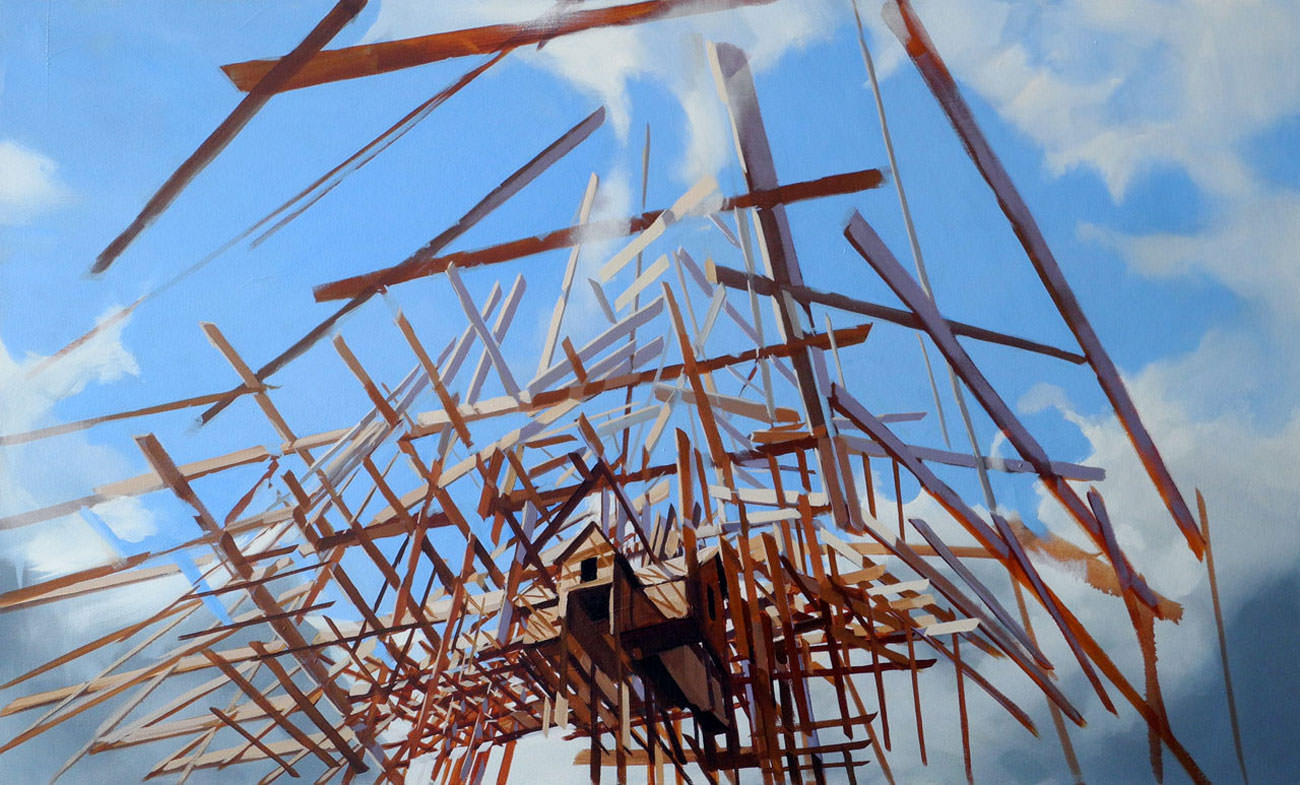

Construction Proposal #9
Who are the artists who have had the most influence on you, past or present?
Recently, two looming figures for different reasons are Gordon Matta-Clark and Charles Birchfield. Birchfield was a local hero back in Cleveland. Gordon Matta-Clark is one of those artists where all of his work is fascinating to me. All of it. In the past I’ve bounced around from Nicolas de Steal and Richard Deibenkorn. As an undergrad it depended on what decade we were following in art history. Now, I find myself going back to some artists I’d forgotten and appreciating them on more of a gut level.
So what are you up to now, and what are you looking forward to?
I am in a group show in my hometown of Cleveland with a pile of admired artists and friends who are up to various things. I’m looking forward to seeing everybody. I will also be represented with three other fantastic artists in Miami this December.
What message or advice do you have for other artists who draw their own inspiration from your work?
I’m flattered if anyone draws inspiration from me. I’m such a bad advice-giver. I guess I would suggest taking risks in your life and your work, whatever that might mean for you.
Finally, If you could eat only one thing for the rest of your life what would it be?
Oh, man. I guess chard would keep me alive the longest, but that would be so boring. Whatever, I’ll live on salmon.
Adaptation #2
